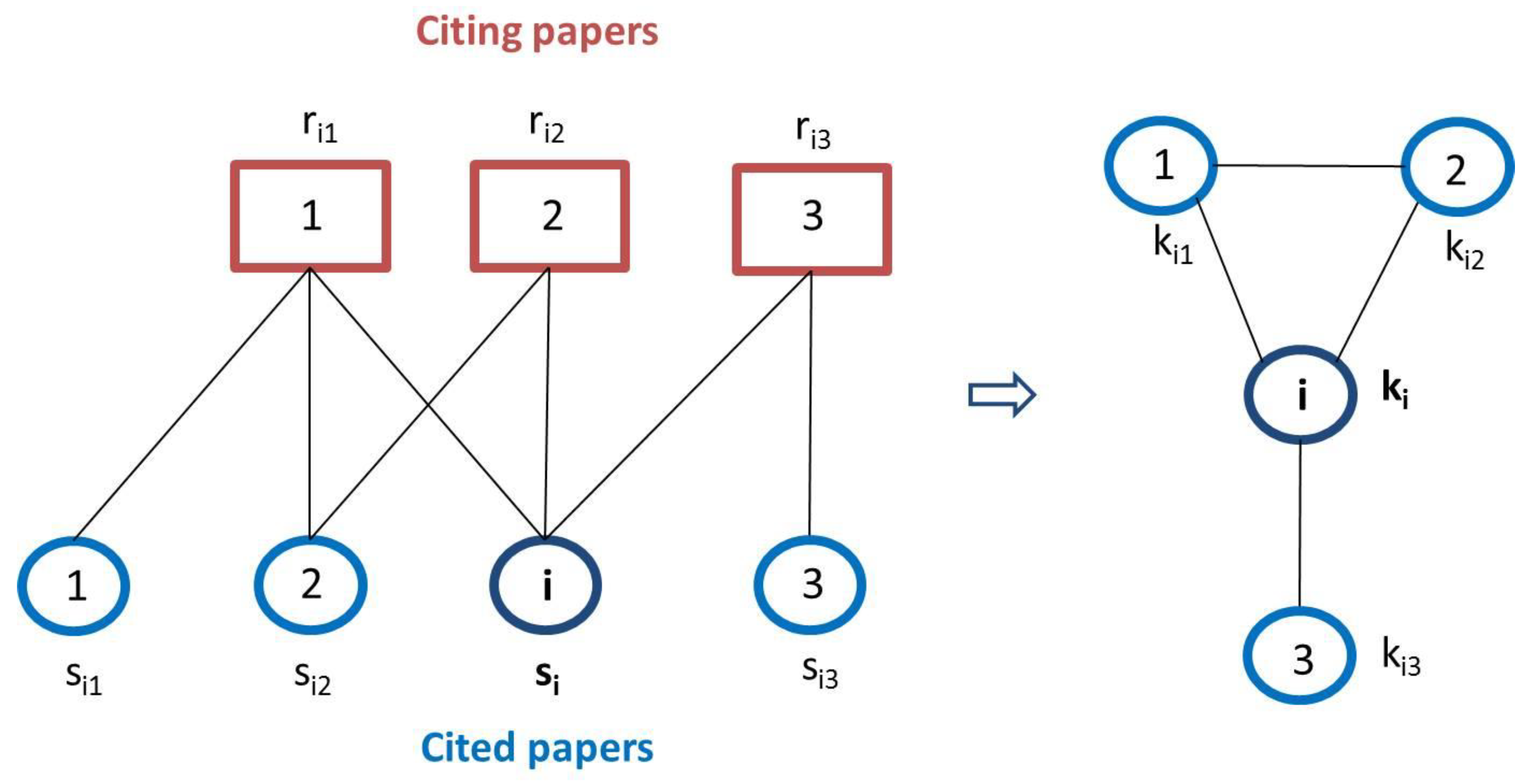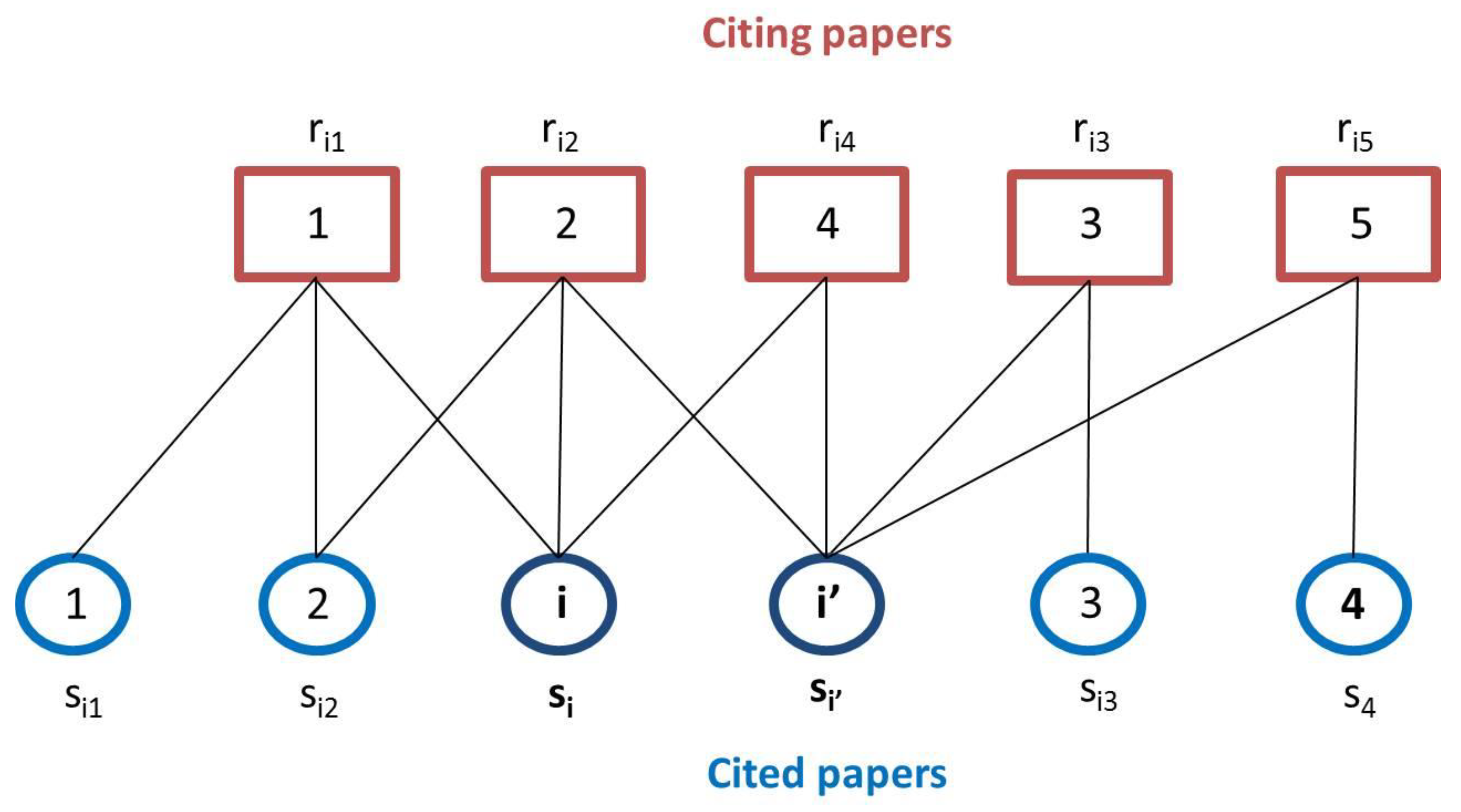Interdisciplinarity Metric Based on the Co-Citation Network
Abstract
1. Introduction
2. Interdisciplinary Metrics Based on the Citation Network
3. Characterization of a Publication’s Field Though the Co-Citation Network: An Interdisciplinarity Metric
4. Extensions
4.1. -Metric for Two Papers Jointly
4.2. -Metric for Papers Jointly
5. Empirical Application
6. Conclusions
Author Contributions
Funding
Conflicts of Interest
References
- Wagner, C.S.; Roessner, J.D.; Bobb, K.; Klein, J.T.; Boyack, K.W.; Keyton, J.; Rafols, I.; Börner, K. Approaches to understanding and measuring interdisciplinary scientific research (IDR): A review of the literature. J. Inf. 2011, 5, 14–26. [Google Scholar] [CrossRef]
- Rafols, I.; Leydesdorff, L.; O’Hare, A.; Nightingale, P.; Stirling, A. How journal rankings can suppress interdisciplinary research: A comparison between Innovation Studies and Business & Management. Res. Policy 2012, 41, 1262–1282. [Google Scholar]
- Sugimoto, C.R.; Weingart, S. The kaleidoscope of disciplinarity. J. Doc. 2015, 71, 775–794. [Google Scholar] [CrossRef]
- Abbott, A. Chaos of Disciplines; University of Chicago Press: Chicago, IL, USA, 2010. [Google Scholar]
- Rafols, I.; Meyer, M. How cross-disciplinary is bionanotechnology? Explorations in the specialty of molecular motors. Scientometrics 2007, 70, 633–650. [Google Scholar] [CrossRef]
- Leydesdorff, L.; Rafols, I. Indicators of the interdisciplinarity of journals: Diversity, centrality, and citations. J. Inf. 2011, 5, 87–100. [Google Scholar] [CrossRef]
- Adams, J.; Loach, T.; Szomszor, M. Interdisciplinary Research: Methodologies for Identification and Assessment; Digital Science: London, UK, 2016. [Google Scholar]
- Wang, Q.; Schneider, J.W. Consistency and validity of interdisciplinarity measures. Quant. Sci. Stud. 2020, 1, 239–263. [Google Scholar] [CrossRef]
- Leydesdorff, L. Betweenness centrality as an indicator of the interdisciplinary of scientific journals. J. Am. Soc. Inf. Sci. Technol. 2007, 58, 1303–1319. [Google Scholar] [CrossRef]
- Freeman, L.C. A Set of Measures of Centrality Based on Betweenness. Sociometry 1977, 40, 35–41. [Google Scholar] [CrossRef]
- Silva, F.N.; Rodrigues, F.A.; Oliveira, O.N.; Costa, L.D.F. Quantifying the interdisciplinarity of scientific journals and fields. J. Inf. 2013, 7, 469–477. [Google Scholar] [CrossRef]
- Leydesdorff, L.; Wagner, C.S.; Bornmann, L. Interdisciplinarity as diversity in citation patterns among journals: Rao-Stirling diversity, relative variety, and the Gini coefficient. J. Inf. 2019, 13, 255–269. [Google Scholar] [CrossRef]
- Barabasi, A.L.; Albert, R. Emergence of scaling in random networks. Science 1999, 286, 509–512. [Google Scholar] [CrossRef] [PubMed]
- Gibbons, M.; Limoges, C.; Nowotny, H.; Schwartzman, S.; Scott, P.; Trow, M. The New Production of Knowledge: The Dynamics of Science and Research in Contemporary Societies; Sage: London, UK, 1994. [Google Scholar]
- Bordons, M.; Morillo, F.; Gómez, I. Analysis of Cross-Disciplinary Research Through Bibliometric Tools. In Handbook of Quantitative Science and Technology Research; Kluwer Academic Publishers: Berlin, Germany, 2006; pp. 437–456. [Google Scholar]
- González-Betancor, S.M.; Dorta-González, P. An indicator of the impact of journals based on the percentage of their highly cited publications. Online Inf. Rev. 2017, 41, 398–411. [Google Scholar] [CrossRef]
- Vinkler, P. The Evaluation of Research by Scientometric Indicators; Chandos Publishing: Oxford, UK, 2010. [Google Scholar]
- Bornmann, L.; Marx, W. Methods for the generation of normalized citation impact scores in bibliometrics: Which method best reflects the judgements of experts? J. Inf. 2015, 9, 408–418. [Google Scholar] [CrossRef]
- Dorta-González, P.; Dorta-González, M.I. Comparing journals from different fields of science and social science through a JCR subject categories normalized impact factor. Scientometrics 2013, 95, 645–672. [Google Scholar] [CrossRef]
- Hutchins, B.I.; Yuan, X.; Anderson, J.M.; Santangelo, G.M. Relative Citation Ratio (RCR): A new metric that uses citation rates to measure influence at the article level. PLoS Biol. 2016, 14, e1002541. [Google Scholar] [CrossRef] [PubMed]
- Janssens, A.C.J.W.; Goodman, M.; Powell, K.R.; Gwinn, M. A critical evaluation of the algorithm behind the Relative Citation Ratio (RCR). PLoS Biol. 2017, 15, e2002536. [Google Scholar] [CrossRef] [PubMed]


| Authors | Journal Metadata | Citations | Nodes in Co-Citation Network | IDRI × 100% |
|---|---|---|---|---|
| Abramo (2018) | Journal of Informetrics 12(3), 590-597 | 18 | 748 | 88.1% |
| Aslam (2018) | Library Management 39(1-2), 78-92 | 6 | 289 | 85.2% |
| Bates (2018) | Journal of Documentation 74(2), 412-429 | 10 | 593 | 95.8% |
| Bawden & Robinson (2018) | Journal of Documentation 74(1), 2-17 | 8 | 729 | 91.9% |
| Boyack et al. (2018) | Journal of Informetrics 12(1), 59-73 | 41 | 1,095 | 71.6% |
| Buschman (2018) | Library Quarterly 88(1), 23-40 | 7 | 456 | 93.1% |
| Clarke (2018) | Library Quarterly 88(1), 41-59 | 11 | 564 | 88.5% |
| Demir (2018) | Journal of Informetrics 12(4), 1296-1311 | 18 | 898 | 91.4% |
| Greifeneder et al. (2018) | Journal of Documentation 74(1), 119-136 | 13 | 633 | 91.9% |
| Hou et al. (2018) | Scientometrics 115(2), 869-892 | 25 | 1,609 | 91.5% |
| Javed & Liu (2018) | Scientometrics 115(1), 395-413 | 20 | 853 | 88.6% |
| Kulczycki et al. (2018) | Scientometrics 116(1), 463-486 | 36 | 945 | 77.1% |
| Lenstra (2018) | Library Quarterly 88(2), 142-159 | 3 | 172 | 94.5% |
| Leydesdorff et al. (2018) | Scientometrics 114(2), 567-592 | 19 | 733 | 83% |
| Li et al. (2018) | Scientometrics 115(1), 1-20 | 25 | 1,411 | 98.2% |
| Lor (2018) | Library Management 39(5), 307-321 | 4 | 142 | 88.2% |
| Martín-Martín et al. (2018) | Journal of Informetrics 12(4),1160-1177 | 68 | 4,723 | 94.1% |
| Mills et al. (2018) | Library Quarterly 88(2), 160-176 | 6 | 197 | 88.3% |
| Mwaniki (2018) | Library Management 39(1-2), 2-11 | 6 | 437 | 89.5% |
| Ocepek (2018) | Journal of Documentation 74(2), 398-411 | 8 | 369 | 85.2% |
| Orr (2018) | Library Quarterly 81(3), 399-423 | 3 | 2305 | 98.9% |
| Pan et al. (2018) | Journal of Informetrics 12(2), 481-493 | 22 | 1,451 | 93.8% |
| Ponelis & Adoma (2018) | Library Management 39(6-7), 430-448 | 2 | 69 | 92% |
| Rubenstein (2018) | Library Quarterly 88(2), 125-141 | 4 | 113 | 96.6% |
| Shepherd et al. (2018) | Library Management 39(8-9), 583-596 | 3 | 146 | 100% |
| Søe (2018) | Journal of Documentation 74(2), 309-332 | 8 | 333 | 91% |
| Spezi et al. (2018) | Journal of Documentation 74(1), 137-161 | 14 | 617 | 85.1% |
| Teixeira & Dobranszki (2018) | Scientometrics 115(2), 1107-1113 | 19 | 507 | 88.9% |
| Thelwall (2018) | Journal of Informetrics 12(2), 430-435 | 20 | 967 | 93% |
| Walter (2018) | Library Management 39(3-4), 154-165 | 4 | 266 | 99.2% |
© 2020 by the authors. Licensee MDPI, Basel, Switzerland. This article is an open access article distributed under the terms and conditions of the Creative Commons Attribution (CC BY) license (http://creativecommons.org/licenses/by/4.0/).
Share and Cite
Hernández, J.M.; Dorta-González, P. Interdisciplinarity Metric Based on the Co-Citation Network. Mathematics 2020, 8, 544. https://doi.org/10.3390/math8040544
Hernández JM, Dorta-González P. Interdisciplinarity Metric Based on the Co-Citation Network. Mathematics. 2020; 8(4):544. https://doi.org/10.3390/math8040544
Chicago/Turabian StyleHernández, Juan María, and Pablo Dorta-González. 2020. "Interdisciplinarity Metric Based on the Co-Citation Network" Mathematics 8, no. 4: 544. https://doi.org/10.3390/math8040544
APA StyleHernández, J. M., & Dorta-González, P. (2020). Interdisciplinarity Metric Based on the Co-Citation Network. Mathematics, 8(4), 544. https://doi.org/10.3390/math8040544






